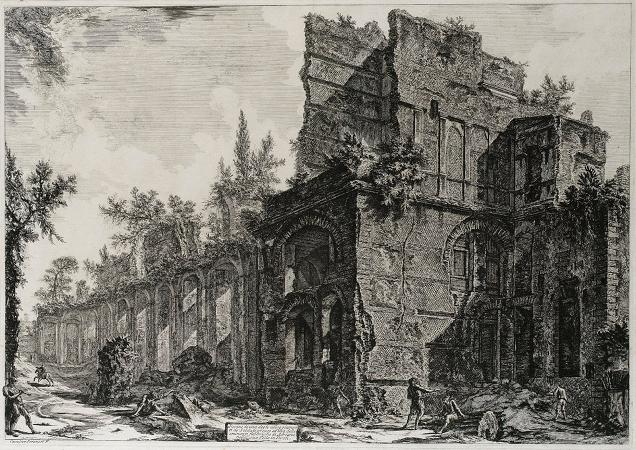Hadrian's Villa (c-110). Hadrian's Villa is a large Roman archaeological complex at Tivoli, Italy. A UNESCO World Heritage Site, it is the property of the Republic of Italy, and has been directed and run by the Polo Museale del Lazio since December 2014. The villa was constructed at Tibur as a retreat from Rome for Roman Emperor Hadrian during the second and third decades of the 2nd century AD. Hadrian is said to have disliked the palace on the Palatine Hill in Rome, leading to the construction of the retreat. It was traditional that the Roman emperor had constructed a villa as a place to relax from everyday life. Previous emperors and Romans with wealth, such as Trajan, had also constructed villas. Many villas were also self-sustaining with small farms and did not need to import food. The picturesque landscape around Tibur had made the area a popular choice for villas and rural retreats. It was reputedly popular with people from the Spanish peninsula who were residents in the city of Rome. This may have contributed to Hadrian's choice of the property-although born in Rome, his parents came from Spain and he may have been familiar with the area during his early life. There may also have been a connection through his wife Vibia Sabina who was the niece of the Emperor Trajan. Sabina's family held large landholdings and it is speculated the Tibur property may have been one of them. A villa from the Republican era formed the basis for Hadrian's establishment. During the later years of his reign, Hadrian actually governed the empire from the villa. Hadrian started using the villa as his official residence around AD 128. A large court therefore lived there permanently and large numbers of visitors and bureaucrats would have to have been entertained and temporarily housed on site. The postal service kept it in contact with Rome 29 kilometres away, where the various government departments were located. It isn't known if Hadrian's wife lived at the villa either on a temporary or permanent basis-his relations with her were apparently rather strained or distant, possibly due to his ambiguous sexuality. Hadrian's parents had died when he was young, and he and his sister were adopted by Trajan. It is possible that Hadrian's court at the villa was predominately male but it's likely that his childhood nurse Germana, to whom he had formed a deep attachment, was probably accommodated there. After Hadrian, the villa was occasionally used by his various successors. Zenobia, the deposed queen of Palmyra, possibly lived here in the 270s. During the decline of the Roman Empire in the 4th century, the villa gradually fell into disuse and was partially ruined as valuable statues and marble were taken away. The facility was used as a warehouse by both sides during the destructive Gothic War between the Ostrogoths and Byzantines. Remains of lime kilns have been found, where marble from the complex was burned to extract lime for building material. In the 16th century, Cardinal Ippolito II d'Este had much of the remaining marble and statues in Hadrian's Villa removed to decorate his own Villa d'Este located nearby. Since that period excavations have sporadically turned up more fragments and sculptures, some of which have been kept in situ or housed on site in the display buildings. Hadrian's Villa is a vast area of land with many pools, baths, fountains and classical Greek and Roman architecture set in what would have been a mixture of landscaped gardens, wilderness areas and cultivated farmlands. The buildings are constructed in travertine, brick, lime, pozzolana, and tufa. The complex contains over 30 buildings, covering at least a square kilometre, of which much is still unexcavated. Villas were typically sited on hilltops, but with its fountains, pools and gardens, Hadrian's villa required abundant sources water, which was supplied by aqueducts feeding Rome, including the Aqua Anio Vetus, Aqua Anio Novus, Aqua Marcia, and Aqua Claudia. To avail themselves of those sources, the villa had to be located on land lower than the aqueduct. The complex of the villa contains many structures from different cultures. For example, the villa has a small Nile river running through it that relates back to the Egyptian Nile river. Also, the villa had Poikilos, which are Greek figures that were seen in ancient Greece. Within all the structures in the villa, there is also a grotto called Hades. All these structures relate back to where Emperor Hadrian visited during his reign. The architecture goes beyond the mere naming of its structures naming after places and monuments seen by Hadrian on his extensive travels across the empire. Certain buildings clearly attempt to recreate specific features of landscapes or architecture that had personal significance for the emperor.
more...













